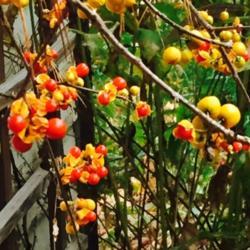| Plant Habit: | Vine |
| Life cycle: | Perennial |
| Sun Requirements: | Full Sun Full Sun to Partial Shade Partial or Dappled Shade Partial Shade to Full Shade |
| Water Preferences: | Mesic |
| Minimum cold hardiness: | Zone 3 -40 °C (-40 °F) to -37.2 °C (-35) |
| Maximum recommended zone: | Zone 8b |
| Plant Height: | 10 to 50 feet or more |
| Leaves: | Deciduous |
| Fruit: | Showy Other: Green to yellow pods split open at maturity, revealing 1 to 2 seeds that are covered in fleshy, reddish-orange arils |
| Fruiting Time: | Late spring or early summer |
| Flowers: | Inconspicuous |
| Flower Color: | Green Other: Greenish-yellow |
| Bloom Size: | Under 1" |
| Flower Time: | Late spring or early summer |
| Wildlife Attractant: | Bees Birds |
| Resistances: | Humidity tolerant Drought tolerant Salt tolerant |
| Toxicity: | Other: All parts of the plant are poisonous. |
| Pollinators: | Bees |
| Miscellaneous: | Dioecious |














